Get in the Action! Fall False Albacore on the Fly
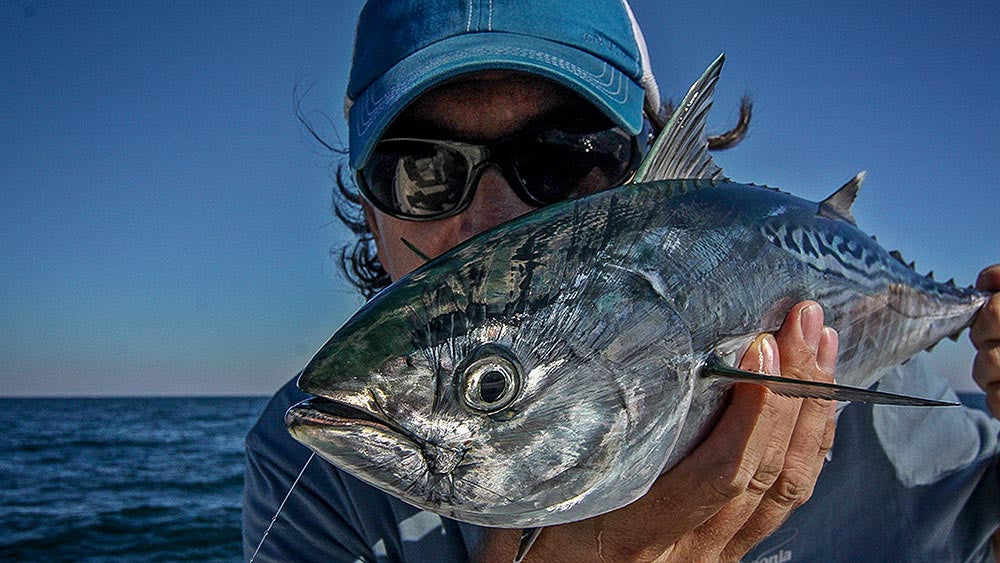

These fish are flat out amazing and if you haven’t been fly fishing for them, you're missing out!
This fall marks the tenth year I’ve engaged in the madness known as fly fishing for false albacore.
I remember my first few trips chasing albies up and down Shackleford and Cape Lookout in North Carolina, all which ended in frustration, not due to a lack of opportunities, but mainly because I had not yet paid my dues and learned the ins and outs of catching these fish.
Somewhere around my third trip, I hooked into my first Albacore on fly. That 20-pound fish took every bit of my backing, and the event is still etched in my mind to this day.
10 years down the road and a ton of albies later, I’m hoping these tips will make your first few outings a little more successful than mine.
There’s a time and a place.
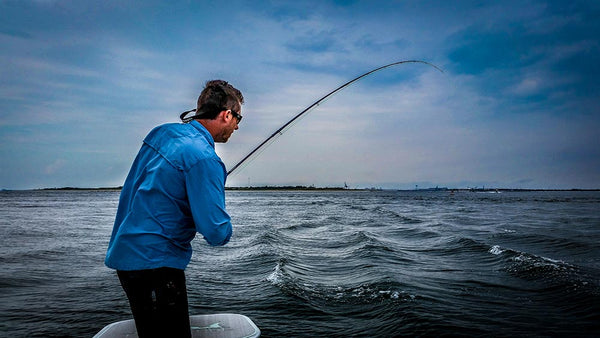
The false albacore (Euthynnus alletteratus) goes by many names and is found up and down the East Coast of the United States.
Common names include “little tunny,” “fat albert,” “bonita” (not to be confused with “bonito”), and our local favorite: “albie."
Albies can be caught from New England all the way down to Florida, but if you ask a fly fisherman in Coastal North Carolina, they’ll argue that they have the best fishery of all.
False albacore can be found offshore in North Carolina most of the year, with a nearshore run along the coast each spring and fall.
The spring run usually occurs in April and May and these fish will be mixed in with Atlantic Bonito and the first Spanish Mackerel of the year. They'll show up along the nearshore wrecks and hard bottom areas and are only around for a few weeks. Since it can be hit or miss, the spring season isn’t as heavily promoted, but the local fly fishermen will put in some time chasing them when they show.

The fall fishery is the one everybody talks about.
I remember ten years ago, when the fishing didn’t really pick up until well into October and it lasted into December, my first Albacore was caught the week of Thanksgiving.
Over the last ten years though, I’ve noticed the fish arriving earlier than they used to.
We sometimes see a few random albies as early as August, with the fishing really picking up late September or early October. The second half of October is usually on fire, and many years they have moved on by mid November.
If I had to pick one area to fish, I'd say the stretch of water from Atlantic Beach, NC to the Cape Lookout Shoals is the top area to get into some action. There are almost always fish in that area.
The second location I’d recommend is from Emerald Isle, NC to Wrightsville Beach, NC. The fishing down along that stretch has been very good the last few years.
Let’s get geared up.
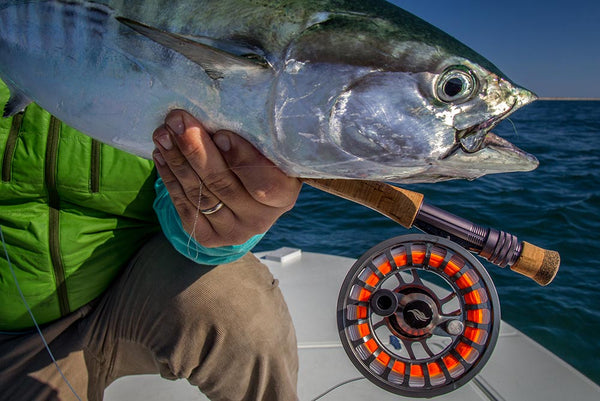
Time to get down to the nitty gritty.
These fish fight with every ounce of strength they have. In it’s heyday, the Cape Lookout area was given the name, “where 10-weights go to die.”
It’s hard to imagine using a rod that can fight a big musky or a 90-pound tarpon and breaking it on a 15-pound tuna, but these are tough fish!
In recent years, there has been a trend towards lighter rods, and many of us have gone down to 8 wts. for the average fish, and reserved the 9 and 10 wts. for the big fish.
Make sure that you have a reel that can handle a minimum of 200 yards of backing and a drag that can handle a fish making a 100-yard dash at 40 mph.
For lines, it’s a coin toss between intermediate sinking lines and floating lines. Both have their merits. I like a slow sinking line (1 to 2 inches per second sink rate) because it allows your line to sit right below the surface of the waves.
A floating line will float up and down over the crests of the waves creating slack, whereas an intermediate line will allow a straight slack free connection between the rod tip and the fly.
The advantage of a floating line is that it is much easier to pick up your line and re-shoot it if you are working a school of feeding fish. When albies are blitzing, they are feeding right at, or very close to the surface, so a fly will get in their zone equally as well whether you are casting a floating or intermediate line.
False Albacore have big eyes and fantastic sight, so make sure you are using fluorocarbon tippet to increase the chances of getting an eat.
Fly rod setups.
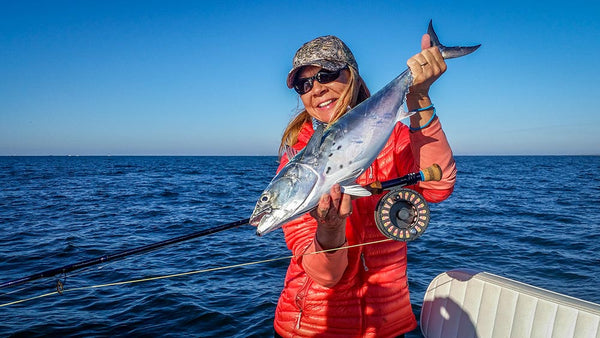
Here's a breakdown of the rods I keep on my boat during Albie season.
For early season albies up to 15 pounds:
- 8 wt. TFO BVK or Mangrove rod.
- Allen Atlas 3 Reel.
- 200 yards of 20 lb. Dacron Backing.
- Scientific Anglers Sonar Sink 30 Clear Tip 350 grains.
- 6 to 8-foot leader including 18 inches of 15 lb. Fluorocarbon Tippet.
For later season albies 15 to 20+ pounds:
- 9 or 10 wt. TFO BVK or Mangrove rod.
- Allen Atlas 4 Reel.
- 200 yards of 30 lb. Dacron Backing.
- Scientific Anglers Sonar Sink 30 Clear Tip 400 grains.
- 6 to 8-foot leader including 18 inches of 20 lb. Fluorocarbon Tippet.
Flies.

False albacore flies tied with Fish-Skull Baitfish Heads.
For fly choice, you have to be ready to match the hatch.
Albies are known to feed on squid, shrimp and other crustaceans, but the great majority of their diet consists of small schooling baitfish.
They will eat larger fish such as spearing, menhaden and mullet, but most of the time they are cued in on silversides and anchovies.
Fly size.
The size of your fly is much more important than color when matching the hatch.
Early season albies, known as “sippers,” are often seen sipping on larval baitfish as small as 0.5 to 0.75 inches long. These baits are usually referred to as “snot bait” because they look like little clear blobs with two tiny black eyes. If that’s what the fish are eating, you have a very slim chance of catching them on a fly much bigger than that.
Make sure you tie a few tiny transparent flies on size 6 or 8 hooks, with tiny black eyes. Most of the time you will find fish feeding on bait from 1.5 to 2.5 inches long, so the majority of your fly box should consist of sparsely tied flies in this length tied on size 1 or 2 hooks.
Sometimes the fish are feeding on larger baits, so always have a handful of larger flies in the 3 to 6-inch range just in case.
Fly color.

Flies in natural colors such as tan over white, olive over white, or grey over white with a small amount of flash work well.
As a guide who is usually on a time crunch, I find myself tying completely white flies and fishing them with great success.
It’s also very worthwhile to have a handful of pink over chartreuse flies for dirty water or overcast conditions.
Fly weight and materials.
I keep a variety of flies both weighted and unweighted.
Most fishermen will use either a Clouser Minnow fly or some variation of a Surf Candy.
Both of these work well for me, but I've added a third fly to my box and will be fishing it a lot this year. Small bucktail streamers tied on a size 2 or 4 hook, weighted with a size small/medium Fish-Skull Baitfish Head are my current go-to fly.
These Fish-Skull Albie Streamers also work well for Spanish mackerel, bluefish and speckled trout here on the coast. Any of these flies can be tied on bucktail or synthetic materials.
Synthetic materials stand up better to the abuse of sharp teethed fish like mackerel and blues, but I feel like I get a few more eats when using natural materials.
Put yourself in a position for success.

So you’re all rigged up and ready to go find some albies, what’s next?
First, let’s talk about locations.
False Albies are usually found anywhere from right in the surf on out to several miles offshore. They can pop up off any stretch of beach along Cape Lookout, Shackleford Banks, the Crystal Coast, Onslow Beach, Topsail and all the way down towards the mouth of the Cape Fear.
They'll also come into the inlets to feed and will occasionally wander a good ways back behind the islands.
Most anglers keep an eye open for fish when coming through the inlet, and then head down the beach until they see fish pop up. I usually run parallel to the beach about a half mile offshore, and keep my eyes peeled to the left and right for breaking fish and flocks of birds.
A lot of times, schools of feeding fish will be followed by flocks of seagulls, terns and pelicans all waiting to get in on the action.
Terns and pelicans don’t mind working for their own live food, so it’s not always a guarantee that there will be albies under them.
Seagulls on the other hand are pretty lazy, and prefer to wait and pick up the leftovers from blitzing albies. Gulls will zig-zag through the sky over schools of albacore and wait for them to intercept a school of baitfish. When the albies find the bait, the gulls will frantically work over the water picking up the leftovers.
Depending on how many birds there are, you can usually see them at a pretty good distance away as you scan along the horizon. As you make your approach, start looking below the birds for the whitewater from the blitzing fish. A school of marauding albacore is a sight to behold as they rip across the surface in every direction with their backs out of the water.
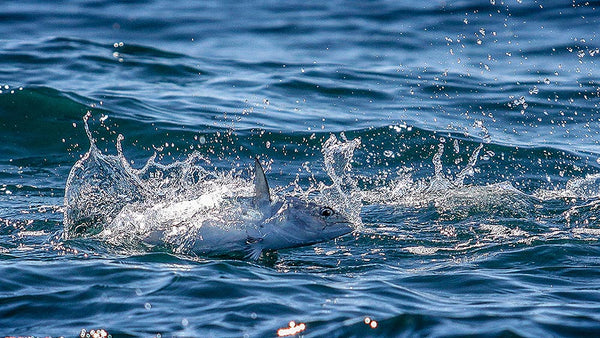
This is the point where many fishermen lose their cool and blow the shot.
It can be hard to calm your nerves when there is so much action and you know you may only have a few seconds to take your shot. This combined with waves, wind, a moving boat and a moving target can make the situation really tough for someone who’s new to the game.
I can promise you one thing — one good cast is always worth more than three poor casts.
Take your time and wait until you are in a good position before you make your cast. Oh, and make sure you practice your double haul before you come down.
Albies rarely stay put, even when devouring a large school of bait. They also have a tendency to feed moving into the wind.
Once you see which direction the fish are moving, have your boat driver position the boat ahead of them and let them come to you. This is always more successful than following behind the fish trying to keep up with them. Get ahead of them and prepare yourself to make a cast as soon as they get in range. If you can’t get out in front of the fish, approach them from the side as they move across the bow of the boat.
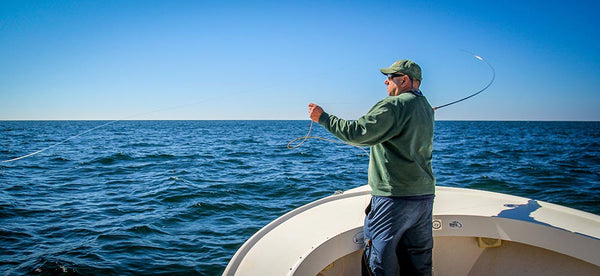
One technique that I’ve found to work really well for fly fishermen is to turn the boat sideways to the fish as you come off throttle.
If you come straight up to a school of fish and cast as you come off of the throttle, the boat will continue to drift toward your cast and there's no way to keep your line tight and your fly moving.
If you turn the boat to the side and the angler casts off the side of the boat, you don’t have the issue of the boat drifting towards your line and you can keep your fly moving the whole time.
Wait until the boat is in neutral and turned to the side of the fish and then make your cast right across the school.
As soon as your fly hits the water, immediately get it moving through the school. If you don’t get an eat, pick it up and shoot it right back across the school.
Fast strips can definitely produce bites, but don’t be afraid to slow your strip down as you work it through the school. The albies will cue in on anything that looks injured so slower strips can work as well as fast ones.
When you get an eat, it will feel like you just strip struck into a cinder block.
When the fish takes off, your only job is to clear the line of any cleats, trolling motors, or body parts it could wrap around until it's off the deck and your reel’s drag goes to work.
Most albies make an initial fast, long run of more than a hundred yards, then allow you to fight them until you’ve almost retrieved your backing and then take off on a second run.

Once you get them near the boat, they usually head straight down and swim in tight circles. This is usually the point where someone high-sticks their rod and snaps it trying to lift the fish, so be careful to fight the fish with the butt of the rod and not the midsection.

When the fish breaks the surface, have your boat mate grab the leader with one hand and grab the fish by the tail. Albacore tails were designed to be perfect handles so grab hold and don’t let him shake loose.
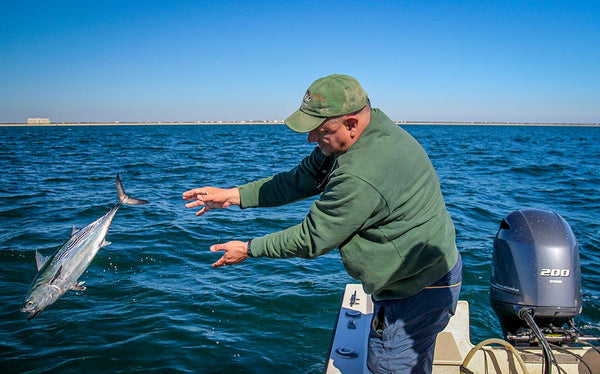
Albies don’t do well being revived in the same manner as most fish, the best way to release them is to hold them at chest height and drop them straight into the water headfirst.
They’ll speed off like a bullet as soon as they hit the water.
Boatless but not hopeless.
If you’ve just read this article and you are not a boat owner, there's still hope.
There are several spots along the coast that you can fish from the sand that albies frequent.
The downside is you lose the ability go looking for fish; you have to sit and wait for them to come to you.
Most of the shore points near inlets can hold fish. Cape Lookout Spit is one such place, and can produce good numbers of fish as they pass through Barden’s Inlet crushing bait. They can pop up along any beachfront, so keep your eyes peeled for working birds down the beach. There will usually be enough bluefish and small jacks to entertain you until the albacore arrive.
There are also several very talented albacore guides in Coastal North Carolina that can put you right on top of fish and coach you through all the steps to catching your first one, and several more.
The Cape Lookout Albacore Festival.
In 2014, a group of fishing friends and admitted "albie addicts" started throwing around the idea of resurrecting the old Cape Lookout Albacore Festival.
With the blessing of past director Charlie Utz, the Cape Lookout Albacore Festival was reborn.
Since North Carolina has such strong military ties, and because we are all grateful for those who serve to protect our freedom, it was decided to name Project Healing Waters Fly Fishing (PHWFF) as the Festival's charity.
Throughout 2014, the Cape Lookout Albacore Festival Board met, planned, made contacts, and laid out the blueprints for the new Albacore Festival. The entire fly fishing community united to donate time, money and goods for the Festival, and thanks to all of them, the Cape Lookout Albacore Festival was a great success.
During the first 2 years, the Albacore Festival has raised $30,000 to help pay for equipment and fishing trips for the disabled PHWFF participants.
The Cape Lookout Albacore Festival is a 2-day event open to the public, along with a private "Healing Waters Day" for disabled military veterans. The Thursday "Healing Waters Day" is organized with PHWFF along with local boat captains, to give disabled veterans the opportunity to get out on the water and chase false albacore on fly.
The Friday of the festival is a pre-fishing day, with casting clinics featuring celebrity fly anglers, and a Captains Party that evening at Anchorage Marina in Atlantic Beach. The Captains Party includes cocktails, dinner, art and fishing gear auctions, raffles, live music, and more.
Saturday is the fishing tournament followed up by an awards banquet that evening. Prizes include top of the line fishing gear and the world famous Copper Albacore trophies.
We're working hard to make the Cape Lookout Albacore Festival the premier fly fishing tournament and festival on the East Coast.
We hope to see you this October 21-22 in Atlantic Beach, North Carolina.
More details can be found at www.CapeLookoutAlbacoreFestival.com.
Want more articles like this?
Join the Flymen mailing list at the bottom of the page!
About John Mauser:

Captain John Mauser owns and operates Tailing Tide Guide Service, a fly fishing and light tackle guide service out of Swansboro, North Carolina. He has been fishing the waters of North Carolina for thirty years. John graduated from UNC Wilmington with a degree in Marine Biology and soon started working for the North Carolina Aquariums. John is the program lead for the local Project Healing Waters Program, which rehabilitates disabled military veterans through fly tying and fly fishing activities. Most of the time, John can be found poling his skiff along the inshore waters of the Crystal Coast. His favorite targets are redfish and false albacore…but he also spends time chasing spanish mackerel, bluefish, speckled trout, sharks, and countless other species. During the Spring spawning run, John fishes for shad, striped bass and other species that are found in North Carolina’s Coastal Rivers. John looks forward to sharing his love of the waters along the Carolina Coast with everyone he meets.



Were coming down around last week of October to fly fish a couple of days ,mainly for Albies…my buddy has been doing this trip a few years now…it will be my first time,I can’t wait.I really enjoyed your article…got to start tying my fly’s.!!! Thx.
Great article. Any guiding services you would recommend? Looking for a charter to take out one fly fisherman and a couple of spin rod fisherman for False Albacore next November.
Excellent article! I live close to the Cape and can echo everything John reported, so come on down (don’t forget your 10 wts. !), and join the fun. From the Giant Drum (Redfish) of the Pamlico Sound & Neuse River to the Albie run there is some “world-class” fly fishing to be found in Eastern NC. Don’t forget the Cape Lookout Fly Fishers Club as well ……… great group to plug-in to for info on fishing these waters.
Thank you everyone for the kind words. If anyone is interested in ways to help out with the Cape Lookout Albacore Festival, feel free to contact me at: johndmauser@yahoo.com
Great article- would love to find out more-especially about the Vets. Can I help?
Leave a comment